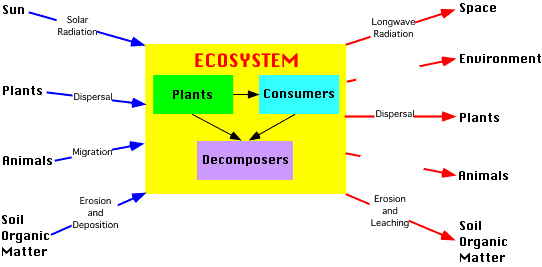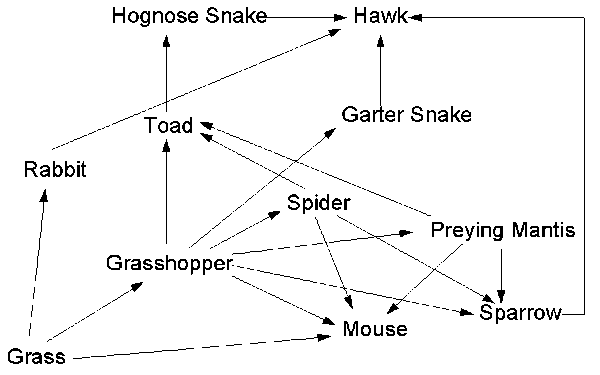![]()
SvS Biology 2000 - No
Webbuttal
8.2.2 There is a flow of energy and
matter in an ecosystem
1. There are many minerals and elements that are the building blocks for all life. Which of the following contains a component that is NOT strictly a part of this?
(A) carbon and phosporous
(B) nitrogen and water
(C) oxygen and sulfur
(D) hydrogen and salts
2. In an ecosystem, these minerals and elements flow from one form to another as they are used by living organisms and then recycled for use again. The flow or movement of these elements and minerals is called the nutrient cycle and it is nature's way of using and re-using the earth's natural resources to support life.
(a) Draw and completely label a simplified
diagram of the carbon cycle
(b) Draw and completely label a simplified diagram of the water cycle
3. Microorganisms have a central role in almost all aspects of nitrogen availability and thus for life support on earth.
(a) Some bacteria are either
free-living or form symbiotic associations with plants or other
organisms (e.g. termites, protozoa) Name the
process by which some bacteria can convert N2 into
ammonia.
(b) Other bacteria bring about transformations of ammonia to nitrate, and of nitrate
to N2 or other
nitrogen gases and many
bacteria and fungi degrade organic matter, releasing fixed nitrogen for
reuse by other organisms. What is this
group of organisms called?
4. Fill in the blanks in the following paragraph:
The green pigment in leaves is called ________________ , it enables plants to grow by making their own food. The process which uses this pigment is known as ____________ , and uses ___________, carbon dioxide and energy from sunlight to produce the simple sugar, ____________. ___________ gas is a waste product of the process, some of which is used for _____________ , and the rest is released into the atmosphere.
5. Fill in the blanks in the following paragraph:
Cellular respiration is a series of chemical reactions that occur in all cells 24 hours per day. In cellular respiration,___________ is broken down in the presence of __________ gas and converted to ATP within the cell. The byproducts of the process are ____________ and ___________. ATP is then used as needed to release energy for cellular functions like growth, reproduction and movement. Cellular respiration takes place in the organelles called _________________ within all eukaryotic cells.
6. Regard the following information:
Plant ----> Caterpillar -----> Bird -----> Dingo
Plant ----> Bird -----> Dingo
Plant ----> Dingo
(a) What are these
examples of?
(b) Utilise the information to construct a food web.
(c) List all organisms that occupy the second trophic level.
(d) List all organisms that are second order consumers.

7. Look at the pretty piccy about matter and energy inputs and outputs of ecosystems.
(a) You'll notice two gaps in
the outputs.
(i) Name the major way that energy is lost from an ecosystem.
(ii) Name the manner in which animal matter is lost from an ecosystem.
(b) Review the food web below:

(i) Identify a pair of
organisms who are first order Competitors.
(ii) If the RABBITS were eradicated (wiped out) what would be the
immediate effect on hawks?
(iii) If the RABBITS were eradicated what would be the immediate effect
on mice?
(c) Sometimes matter accumulates in an ecosystem. This process is known as "Biomagnification." Read the following extract from http://www.marietta.edu/~biol/102/ecosystem.html
The "best" example of biomagnification comes from DDT. This long-lived pesticide (insecticide) has improved human health in many countries by killing insects such as mosquitoes that spread disease. On the other hand, DDT is effective in part because it does not break down in the environment. It is picked up by organisms in the environment and incorporated into fat. Even here, it does no real damage in many organisms (including humans). In others, however, DDT is deadly or may have more insidious, long-term effects. In birds, for instance, DDT interferes with the deposition of calcium in the shells of the bird's eggs. The eggs laid are very soft and easily broken; birds so afflicted are rarely able to raise young and this causes a decline in their numbers. This was so apparent in the early 1960's that it led the scientist Rachel Carson to postulate a "silent spring" without the sound of bird calls. Her book "Silent Spring" led to the banning of DDT, the search for pesticides that would not biomagnify, and the birth of the "modern" environmental movement in the 1960's. Birds such as the bald eagle have made comebacks in response to the banning of DDT in the US. Ironically, many of the pesticides which replaced DDT are more dangerous to humans, and, without DDT, disease (primarily in the tropics) claims more human lives.
(i) Summarise the qualities of DDT that enable
it to "magnify" in the ecosystem.
(ii) Use your knowledge of food webs and biomass pyramids to explain how Biomagnification
occurs.

8. Look at the following electromicrograph of a mitochondrion.
(a) On you answer sheet,
label the diagram to show each of the following substructures:
(i) cristae
(ii) matrix
(b) Answer True or false to
the following about mitochondria:
(i) they may contain DNA
(ii) they are responsible for
carrying out photosynthesis
(iii) they are only present
in animal cells
(iv) they may contain
ribosomes
(v) the pectoral muscle cells
of a hummingbird will contain more of these than will a human heart cell.
Now whaddya want?
S. van Strien